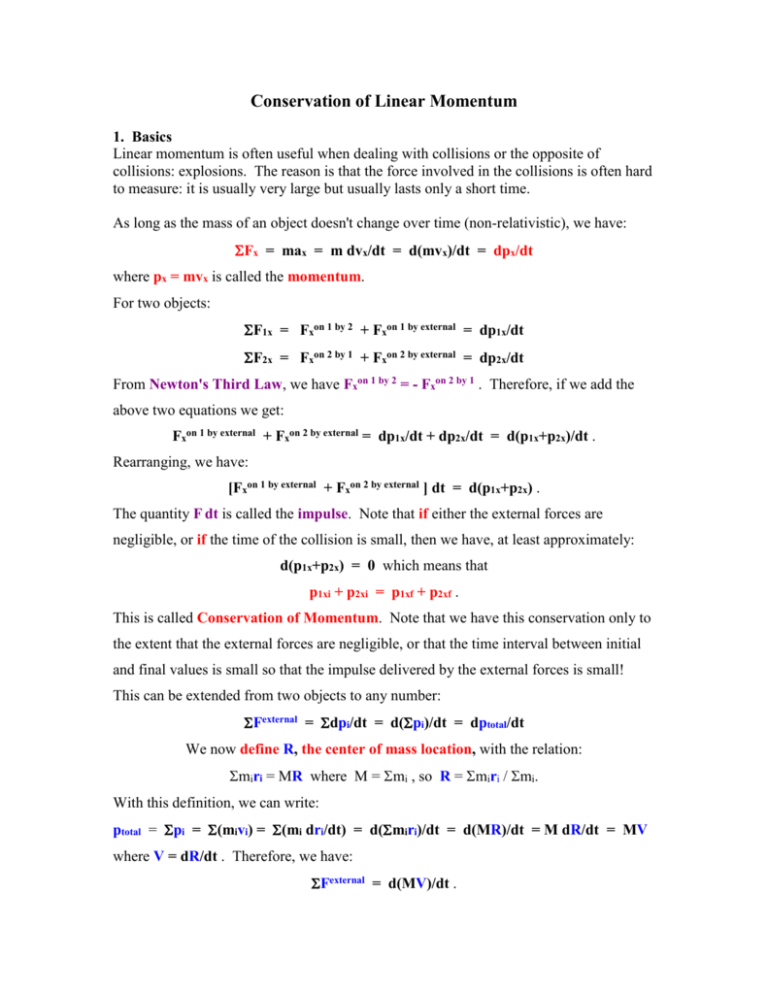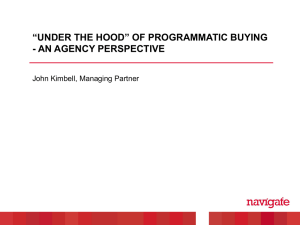Momentum
advertisement

Conservation of Linear Momentum
1. Basics
Linear momentum is often useful when dealing with collisions or the opposite of
collisions: explosions. The reason is that the force involved in the collisions is often hard
to measure: it is usually very large but usually lasts only a short time.
As long as the mass of an object doesn't change over time (non-relativistic), we have:
Fx = max = m dvx/dt = d(mvx)/dt = dpx/dt
where px = mvx is called the momentum.
For two objects:
F1x = Fxon 1 by 2 + Fxon 1 by external = dp1x/dt
F2x = Fxon 2 by 1 + Fxon 2 by external = dp2x/dt
From Newton's Third Law, we have Fxon 1 by 2 = - Fxon 2 by 1 . Therefore, if we add the
above two equations we get:
Fxon 1 by external + Fxon 2 by external = dp1x/dt + dp2x/dt = d(p1x+p2x)/dt .
Rearranging, we have:
[Fxon 1 by external + Fxon 2 by external ] dt = d(p1x+p2x) .
The quantity F dt is called the impulse. Note that if either the external forces are
negligible, or if the time of the collision is small, then we have, at least approximately:
d(p1x+p2x) = 0 which means that
p1xi + p2xi = p1xf + p2xf .
This is called Conservation of Momentum. Note that we have this conservation only to
the extent that the external forces are negligible, or that the time interval between initial
and final values is small so that the impulse delivered by the external forces is small!
This can be extended from two objects to any number:
Fexternal = dpi/dt = d(pi)/dt = dptotal/dt
We now define R, the center of mass location, with the relation:
miri = MR where M = mi , so R = miri / mi.
With this definition, we can write:
ptotal = pi = (mivi) = (mi dri/dt) = d(miri)/dt = d(MR)/dt = M dR/dt = MV
where V = dR/dt . Therefore, we have:
Fexternal = d(MV)/dt .
2. Example: Loading a coal train
Consider the case of a big hopper kept full of coal that funnels coal at a constant rate. A
train engine pulls coal cars under the hopper at a constant speed so that the coal cars are
evenly loaded. How much power will the engine have to supply to keep the train moving
at constant speed (ignoring the effects of air resistance and friction in the wheel
bearings)?
a) Use Conservation of Energy: coal initially at rest must receive kinetic energy to get it
moving at the same speed as the train:
Power = d(Energy)/dt = (1/2)(dM)v2/dt = (1/2)(dM/dt)v2 .
b) Use Momentum: Fengine = d(Mv)/dt = (dM/dt)v
Power = d Fds /dt = Fv = (dM/dt)vv = (dM/dt)v2 .
Notice that the results from a) and b) are not the same! What's wrong?
Does conservation of energy apply? Is there friction? What does friction act on?
Does friction act on the coal to get it moving up to the speed of the train?
Does friction act on the coal cars?
Notice that there is the same force and distance for both the friction acting on the coal
and for the friction acting on the coal cars! Thus, the train engine must provide not only
the power to get the coal moving, it must also provide the energy that ends up heating the
coal cars due to the friction of the sliding coal on the cars! The combination does in fact
give the same result as that calculated using the momentum concept.
b) Example: Rockets
Explosion (things flying out) is opposite of collision (things flying together), so we can
use momentum. In the following, let's ignore air resistance and look only at the rocket
engine and gravity in one dimension. We will first start out with a finite amount of fuel,
M, being thrown out the back of the rocket with a speed of vexh (relative to the rocket)
during a small but finite interval of time, t. This will cause the initial speed of the
rocket, V, to increase by a small but finite amount, V. Note that the mass of the rocket,
including its fuel, changes since part of the fuel is thrown out by the rocket engine, so the
final mass of the rocket will be M-M. Note that we subtract vexh to indicate that this
speed is directed opposite to the rocket, and this makes vexh a positive number in all that
follows.
Fexternal = dptotal/dt
-M g = (pf - pi) / t
pf-rocket = [M-M]*[V+V] ; pf-fuel = M * [V-vexh] ;
pf-total = = [M-M]*[V+V] + M * [V-vexh]
pi-rocket = [M-M]*V ; pi-fuel = M*V ;
pi-total = MV
Therefore, putting in pf and pi we get:
-M g = {[M-M]*[V+V] + M * [V-vexh] - MV } / t
Writing out all the terms, we get:
-Mg = {MV - M*V + M*V - M*V + M*V - M*vexh - MV } / t
Cancelling out terms gives:
-Mg = {M*V - M*vexh - M*V} / t
-Mg = M*(V/t) - (M/t)*vexh - (M/t)*V
If we now take the limit as t goes to zero, we see that (V/t) becomes dV/dt, that
(M/t) becomes -dM/dt [the negative sign is introduced, since M/t was a positive
quantity, but dM/dt is negative since the mass is decreasing with time as we burn the
fuel], and that the factor V becomes zero. Thus we have:
-Mg = M*dV/dt + vexh*dM/dt , or
M*dV/dt = -Mg - vexh*dM/dt .
(Eq. 1)
We see that the acceleration depends on the force of gravity and the thrust of the rocket,
where Fthrust = -vexh*dM/dt . Note that dM/dt is a negative number since the mass, M, is
decreasing with time, so Fthrust is positive. Note that Eq. 1 is a differential equation where
both M and V depend on time.
Special case: If the rocket just hovers, the dV/dt = 0, and we can then try to solve Eq. 1
to see how long the rocket can hover. This is the situation in homework problem 25 (Ch
4, #7).
Special case: If we burn the fuel at a constant rate, R, in the engines, then the quantity
dM/dt = -R (since the mass decreases with time, dM/dt is negative), and the mass, M, is
then M(t) = Mo-Rt . Equation 1 then becomes:
dV/dt = -g + vexh*R/(Mo-Rt)
Bringing the dt to the other side, and integrating gives:
V - Vo = -gt + vexhR 0t dt / (Mo-Rt) = -gt + vexh ln[1/{1-(R/Mo)t}] , or
V(t) = Vo - gt - vexh ln[1-(R/Mo)t]
Check: as t goes to zero, V goes to Vo; units work out; as Rt approaches Mo, V(t)
approaches positive infinity. Note that Rt can’t actually go to zero since the rocket can’t
be made up entirely of fuel – it needs at least the engine and fuel tank.
Homework Problem #24: Ballistic Pendulum A bullet of mass, m, is fired at the bob
of a pendulum (mass of bob = M) of length, L, and the bullet becomes embedded
in the bob and causes the bob (plus bullet) to swing up to an angle, , with the
vertical. Express the speed of the bullet in terms of the parameters m, M, L, and
, by using the appropriate conservation principles.
Homework Problem #25: Assume a lunar lander has a rocket engine that have an
exhaust speed of 1500 m/s, and that 1/3 of the mass of the lander initially is fuel.
The acceleration due to gravity on the Moon is 1/6 that of earth. How long can
the lunar lander hover above the Moon’s surface before running out of fuel?







